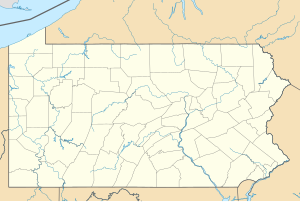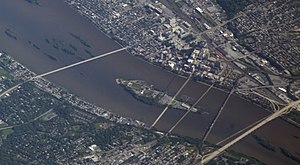Walnut Street Bridge (Susquehanna River)
Coordinates: 40 ° 15 ′ 27 ″ N , 76 ° 53 ′ 10 ″ W.
| Walnut Street Bridge | ||
|---|---|---|
| East part of the bridge between City Island and Harrisburg | ||
| use | footbridge | |
| Crossing of | Susquehanna River | |
| place | Harrisburg and Wormleysburg , Pennsylvania | |
| Entertained by | PennDOT | |
| construction | Truss bridge | |
| overall length | 427 m (east side until 1996) 433 m (west side) 236 m (island section) |
|
| Longest span | 73 m | |
| start of building | 1889 | |
| completion | 1890 | |
| planner | Albert Lucius | |
| location | ||
|
|
||
| Harrisburg with City Island on Susquehanna | ||
|
The bridges at the level of the river island from left to right: M. Harvey Taylor Memorial Bridge Walnut Street Bridge Market Street Bridge Cumberland Valley Railroad Bridge Philadelphia and Reading Railroad Bridge ( Dock Street Dam ) John Harris Bridge |
||
The Walnut Street Bridge , also called People's Bridge , is a pedestrian bridge over the Susquehanna River between Harrisburg and City Island in the state of Pennsylvania in the USA . The former road bridge was opened in 1890 and expanded into a pedestrian and cycle path in 1972. It originally ran as far as Wormleysburg on the west bank of the Susquehanna, but a flood and ice drift as a result of a Nor'easter in 1996 displaced two bridge piers and then tore some trusses on the west side of the bridge with it. The remaining parts of the bridge on this side have been closed since then. The Walnut Street Bridge was listed on the National Register of Historic Places in 1972 and was added to the list of Historic Landmarks in Civil Engineering in 1997 .
history
With the construction of the People's Bridge , the monopoly of the Harrisburg Bridge Company was broken, which built the first bridge over the Susquehanna on the site of today's Market Street Bridge with the Camelback Bridge , and since its completion in 1820 has levied high tolls . In early February 1889, The People's Bridge Company of Harrisburg was founded . After some legal disputes with the operators of the Camelback Bridge , construction work began in April and was completed a year later. The official opening took place on April 25, 1890. Planning and construction was done by Dean and Westbrook from New York City , the engineer responsible was Albert Lucius. The superstructure was built by the Phoenix Bridge Company from Phoenixville .
After the opening there was a price war between the two bridge operators, which led to a reduction in the tolls for both bridges. From 1894 to 1936 a tram track ran over the People's Bridge , which is located in Harrisburg at the height of today's eponymous Walnut Street . In addition to many other road bridges, the state of Pennsylvania acquired the bridge in the 1950s and made it toll-free in 1957, the current operator is the Pennsylvania Department of Transportation (PennDOT).
A flood caused by Hurricane Agnes in late June 1972 almost washed over the pavement beam and accumulating debris caused damage to some areas of the bridge. As a result, it was permanently closed to car traffic and converted into a pedestrian bridge. In the same year, the Walnut Street Bridge was added to the National Register of Historic Places (NRHP #: 72001115). A flood with heavy ice as a result of the North American blizzard in 1996 shifted two bridge piers, as a result of which two trusses of the western section were carried away on January 20 and destroyed at the subsequent Market Street Bridge . The pillars and another truss had to be demolished later. The western part of the bridge that remains today has been closed since then.
description

The truss bridge is divided into two parts by a 236 m long section on the river island. The eastern part originally consisted of eight truss girders with a length of 53.3 m, five of which remain. The eastern part, which is still in use today, consists of four further 53.3 m long truss girders starting from the island side, followed by three longer 73.2 m long girders in the direction of Harrisburg. The connection on the island consisted of a wooden trestle bridge until 1907 and was then replaced by an earth dam.
The lattice girders with the carriageway below consist of two special parallel-belted stud frameworks, which are reinforced by additional lateral struts in the lower half (Baltimore framework) and connected to one another by horizontal struts above and in the middle. The individual elements of the beams, which are held together by bolt and rivet connections, are made of wrought iron. The carriageway girder is 6.7 m wide and offers space between the 10.7 m high trusses of a 5.5 m wide carriageway. In addition, the bridge had a footpath on both sides on lateral brackets on the outside of the deck girder. The roadway and sidewalks were originally implemented by wooden planks 1950 through grates were replaced. When it was converted into a pedestrian bridge in 1972, these were partially replaced on the south side by a concrete paving and the sidewalks on the outside were removed.
literature
- Richard M. Casella: Walnut Street Bridge, Pennsylvania Historic Bridges Recording Project. Historic American Engineering Record, HAER No. PA-412, Washington, DC 1996.
- Erik V. Fasick: Harrisburg and the Susquehanna River. Images of America, 2015, ISBN 978-1467122986 , pp. 15-32.
Web links
- Walnut Street Bridge, spanning Susquehanna River at Walnut Street (State Route 3034), Harrisburg, Dauphin County, PA. Historic American Engineering Record , HAER No. PA-412.
- Walnut Street Bridge collapse, Harrisburg PA 1996. Reported by WHTM-TV on YouTube .
Individual evidence
- ^ Richard M. Casella: Walnut Street Bridge, Pennsylvania Historic Bridges Recording Project. HAER No. PA-412, Washington, DC 1996, pp. 5-11.
- ^ A b c Richard M. Casella: Walnut Street Bridge, Pennsylvania Historic Bridges Recording Project. HAER No. PA-412, Washington, DC 1996, pp. 12-16.
- ↑ EF LaFond, Jr .: Walnut Street Bridge - National Register of Historic Places Inventory Nomination form. United State Department of the Interior, National Park Service, 1972.
- ^ Walnut Street Bridge collapse, Harrisburg PA 1996. Report from WHTM-TV on YouTube . Retrieved December 30, 2017.
- ^ A b Richard M. Casella: Walnut Street Bridge, Pennsylvania Historic Bridges Recording Project. HAER No. PA-412, Washington, DC 1996, pp. 2 f.
- ↑ Erik V. Fasick: Harrisburg and the Susquehanna River. Images of America, 2015, ISBN 978-1467122986 , pp. 15–32, here pp. 22–25.



